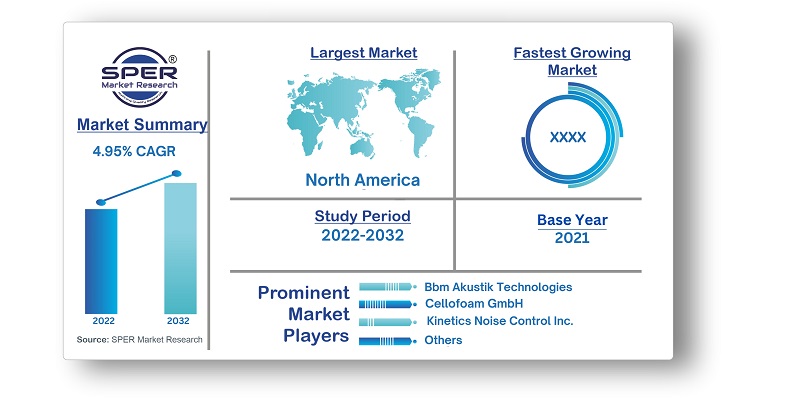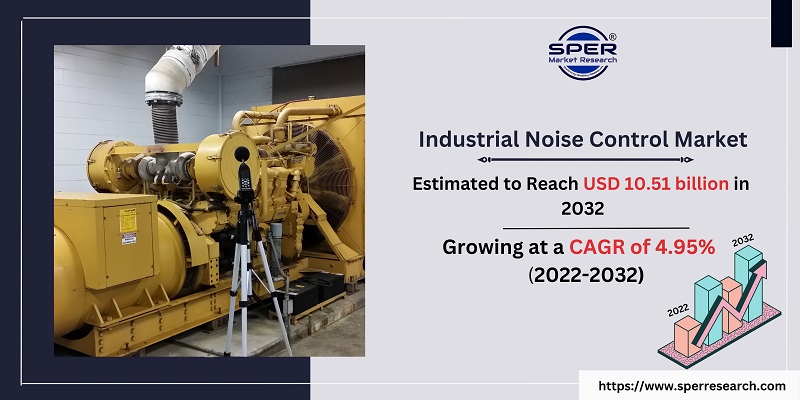
Industrial Noise Control Market Growth, Share, Trends, Scope, Revenue and Future Outlook 2032
Industrial Noise Control Market Size- By Product Type, By Material Type, By Application, By End User- Regional Outlook, Competitive Strategies and Segment Forecast to 2032
| Published: Mar-2023 | Report ID: IACT2359 | Pages: 1 - 244 | Formats*: |
| Category : Information & Communications Technology | |||


| Report Metric | Details |
| Market size available for years | 2019-2032 |
| Base year considered | 2021 |
| Forecast period | 2022-2032 |
| Segments covered | By Type, By Application, By End User |
| Regions covered | By Product Type, By Material Type, By Application, By End User |
| Companies Covered | Bbm Akustik Technologies, Cellofoam GmbH & Co. KG, CSTI acoustics , Durr Universal Inc., eNoiseControl., Kinetics Noise Control Inc., KSM Group Shaver Industries, Linder GmbH, Merford Holding B.V REBLOC GmbH, Pyrotek ArtUSA Industries Inc., R. Kohlhauer GmbH, Sintesi PLC, Sound Seal Inc., Technofirst SA Stopson Italiana, Total Vibration Solutions Ltd., Ventac Co. Ltd. |
- Maintenance and Cleaning Service Providers
- Distributors and Suppliers
- Regulatory Agencies
- Research and Development Professionals
- Industrial Companies
- Inline Arrestor
- End-of-Line
- Polymer
- Composite
- Glass
- Metal
- Fibric
- Internal Noise Control
- External Noise Control
- Manufacturing
- Construction
- Mining
- Healthcare
- Asia-Pacific
- Europe
- Middle East & Africa
- North America
- Latin America
- Global Industrial Noise Control Market Size (FY’2019-FY’2032)
- Overview of Global Industrial Noise Control Market
- Segmentation of Global Industrial Noise Control Market By Product Type (Inline Arrestor, End-of-Line)
- Segmentation of Global Industrial Noise Control Market By Material Type (Polymer, Composite, Glass, Metal, Fibric)
- Segmentation of Global Industrial Noise Control Market By Application (Internal Noise Control, External Noise Control)
- Segmentation of Global Industrial Noise Control Market By End User (Manufacturing, Construction, Mining, Healthcare, Other End User)
- Statistical Snap of Global Industrial Noise Control Market
- Growth Analysis of Global Industrial Noise Control Market
- Problems and Challenges in Global Industrial Noise Control Market
- Competitive Landscape in the Global Industrial Noise Control Market
- Impact of COVID-19 and Demonetization on Global Industrial Noise Control Market
- Details on Recent Investment in Global Industrial Noise Control Market
- Competitive Analysis of Global Industrial Noise Control Market
- Global Industrial Noise Control Market Key Players
- SWOT Analysis of Global Industrial Noise Control Market
- Global Industrial Noise Control Market Future Outlook and Projections (FY’2019-FY’2032)
- Recommendations from Analyst
1.1. Scope of the report1.2. Market segment analysis
2.1 Research data source2.1.1 Secondary data2.1.2 Primary data2.1.3 SPER’s internal database2.1.4 Premium insight from KOL’s2.2 Market size estimation2.2.1 Top-down and Bottom-up approach2.3 Data triangulation
4.1. Driver, Restraint, Opportunity and Challenges analysis4.1.1 Drivers4.1.2 Restraints4.1.3 Opportunities
4.1.4 Challenges
4.2. COVID-19 Impacts of the Global Industrial Noise Control Market
5.1. SWOT analysis5.1.1 Strengths5.1.2 Weaknesses5.1.3 Opportunities5.1.4 Threats5.2. PESTEL analysis5.2.1 Political landscape5.2.2 Economic landscape5.2.3 Social landscape5.2.4 Technological landscape5.2.5 Environmental landscape5.2.6 Legal landscape5.3. PORTER’S five forces analysis5.3.1 Bargaining power of suppliers5.3.2 Bargaining power of Buyers5.3.3 Threat of Substitute5.3.4 Threat of new entrant5.3.5 Competitive rivalry5.4. Heat map analysis
6.1 Global Industrial Noise Control Manufacturing Base Distribution, Sales Area, Product Type6.2 Mergers & Acquisitions, Partnerships, Product Launch, and Collaboration in Global Industrial Noise Control Market
7.1 Inline Arrestor7.2 End-of-Line
8.1 Polymer8.2 Composite8.3 Glass8.4 Metal8.5 Fibric
9.1 Internal Noise Control9.2 External Noise Control
10.1 Manufacturing10.2 Construction10.3 Mining10.4 Healthcare10.5 Other End-User
11.1 Global Industrial Noise Control Market and Market Share by Region (2019-2025)11.2 Global Industrial Noise Control Market and Market Share by Region (2026-2032)11.3 Asia-Pacific11.3.1 Australia11.3.2 China11.3.3 India11.3.4 Japan11.3.5 South Korea11.3.6 Rest of Asia-Pacific11.4 Europe11.4.1 France11.4.2 Germany11.4.3 Italy11.4.4 Spain11.4.5 United Kingdom11.4.6 Rest of Europe11.5 Middle East and Africa11.5.1 Kingdom of Saudi Arabia11.5.2 United Arab Emirates11.5.3 Rest of Middle East & Africa11.6 North America11.6.1 Canada11.6.2 Mexico11.6.3 United States11.7 Latin America11.7.1 Argentina11.7.2 Brazil11.7.3 Rest of Latin America
12,1 Bbm Akustik Technologies12,1,1 Company details12.1.1 Financial outlook12.1.2 Product summary12.1.3 Recent developments12.2 Cellofoam GmBH & Co.KG12.2.1 Company details12.2.2 Financial outlook12.2.3 Product summary12.2.4 Recent developments12.3 CSTI Acoustics12.3.1 Company details12.3.2 Financial outlook12.3.3 Product summary12.3.4 Recent developments12.4 Durr Universal Inc12.4.1 Company details12.4.2 Financial outlook12.4.3 Product summary12.4.4 Recent developments12.5 eNoise Control12.5.1 Company details12.5.2 Financial outlook12.5.3 Product summary12.5.4 Recent developments12.6 Kinetics Noise Control Inc12.6.1 Company details12.6.2 Financial outlook12.6.3 Product summary12.6.4 Recent developments12.7 KSM Group Shaver Industries12.7.1 Company details12.7.2 Financial outlook12.7.3 Product summary12.7.4 Recent developments12.8 Linder Noise Control Inc12.8.1 Company details12.8.2 Financial outlook12.8.3 Product summary12.8.4 Recent developments12.9 Merford Holding B.V Rebloc GmbH12.9.1 Company details12.9.2 Financial outlook12.9.3 Product summary12.9.4 Recent developments12.10 Pyrotech ArtUSA Industries Inc12.10.1 Company details12.10.2 Financial outlook12.10.3 Product summary12.10.4 Recent development12.11 R.Kohlhauer GmbH12.11.1 Company details12.11.2 Financial outlook12.11.3 Product summary12.11.4 Recent developments12.12 Sintesi PLC12.12.1 Company details12.12.2 Financial outlook12.12.3 Product summary12.12.4 Recent developments12.13 Sound Seal Inc12.13.1 Company details12.13.2 Financial outlook12.13.3 Product summary12.13.4 Recent developments12.14 Technofirst SA Stopson Italiana12.14.1 Company details12.14.2 Financial outlook12.14.3 Product summary12.14.4 Recent developments12.15 Top Vibration Solution Ltd.12.15.1 Company details12.15.2 Financial outlook12.15.3 Product summary12.15.4 Recent developments12.16 Ventac Co. Ltd12.16.1 Company details12.16.2 Financial outlook12.16.3 Product summary12.16.4 Recent developments
SPER Market Research’s methodology uses great emphasis on primary research to ensure that the market intelligence insights are up to date, reliable and accurate. Primary interviews are done with players involved in each phase of a supply chain to analyze the market forecasting. The secondary research method is used to help you fully understand how the future markets and the spending patterns look likes.
The report is based on in-depth qualitative and quantitative analysis of the Product Market. The quantitative analysis involves the application of various projection and sampling techniques. The qualitative analysis involves primary interviews, surveys, and vendor briefings. The data gathered as a result of these processes are validated through experts opinion. Our research methodology entails an ideal mixture of primary and secondary initiatives.



Frequently Asked Questions About This Report
PLACE AN ORDER
Year End Discount
Sample Report
Pre-Purchase Inquiry
NEED CUSTOMIZATION?
Request CustomizationCALL OR EMAIL US
100% Secure Payment






Related Reports
Our Global Clients
Our data-driven insights have influenced the strategy of 200+ reputed companies across the globe.




















